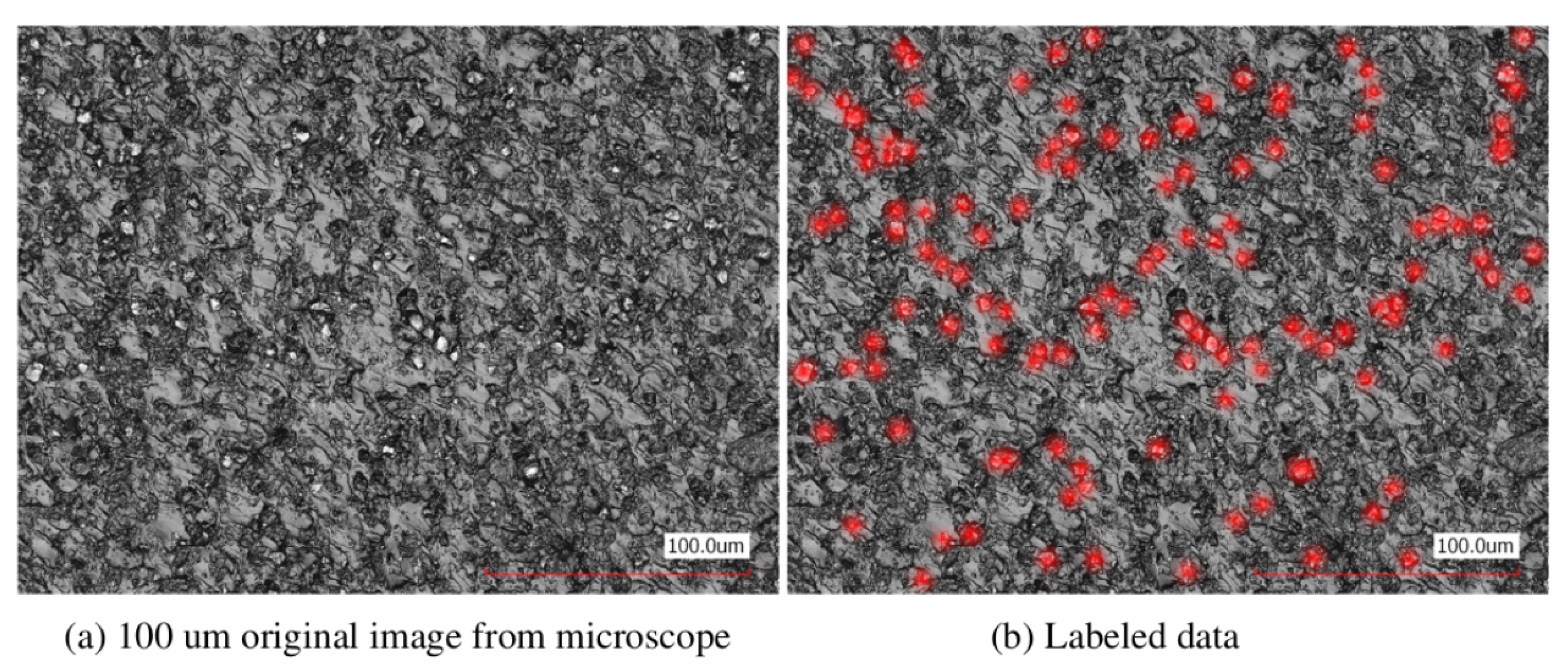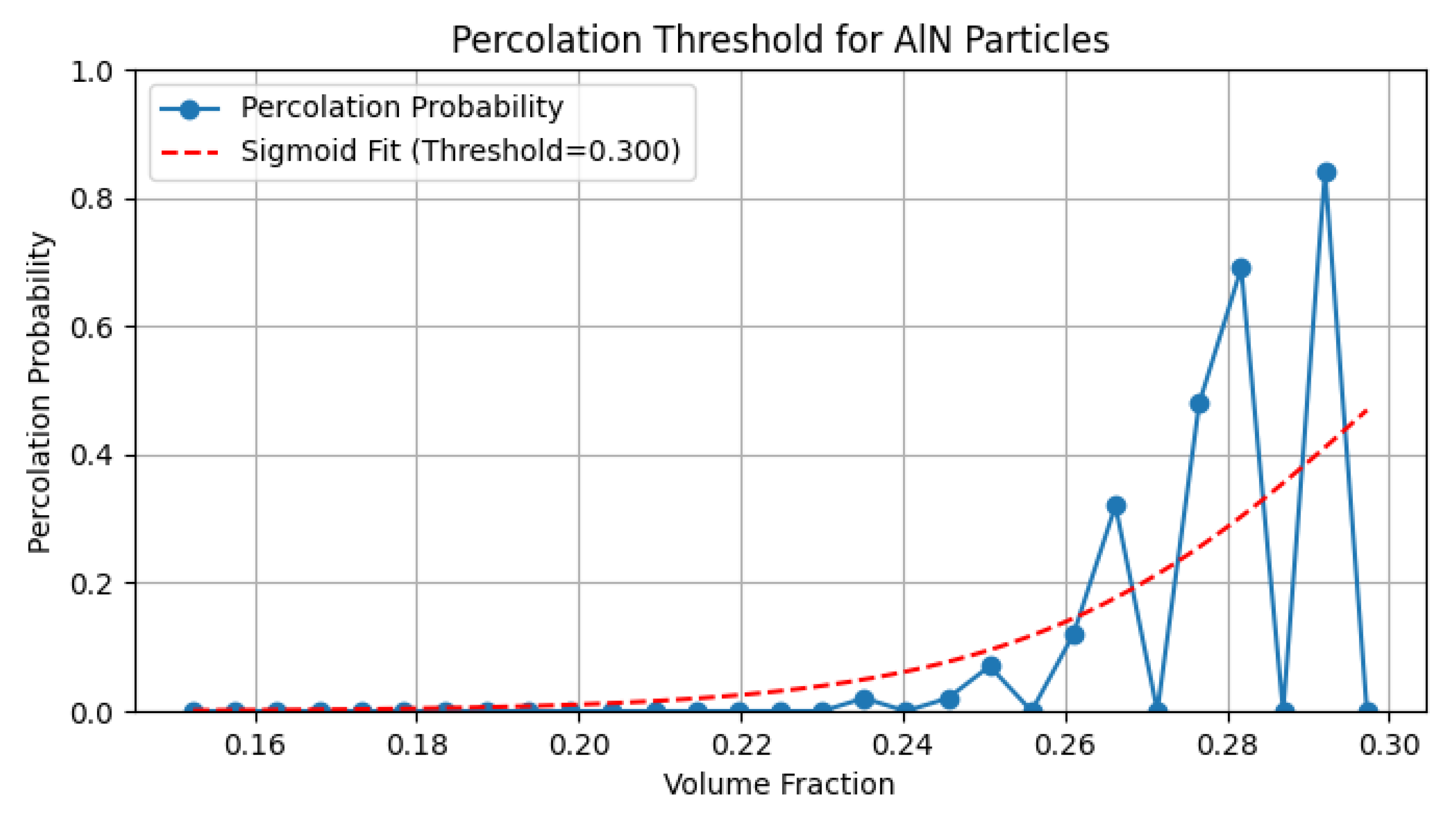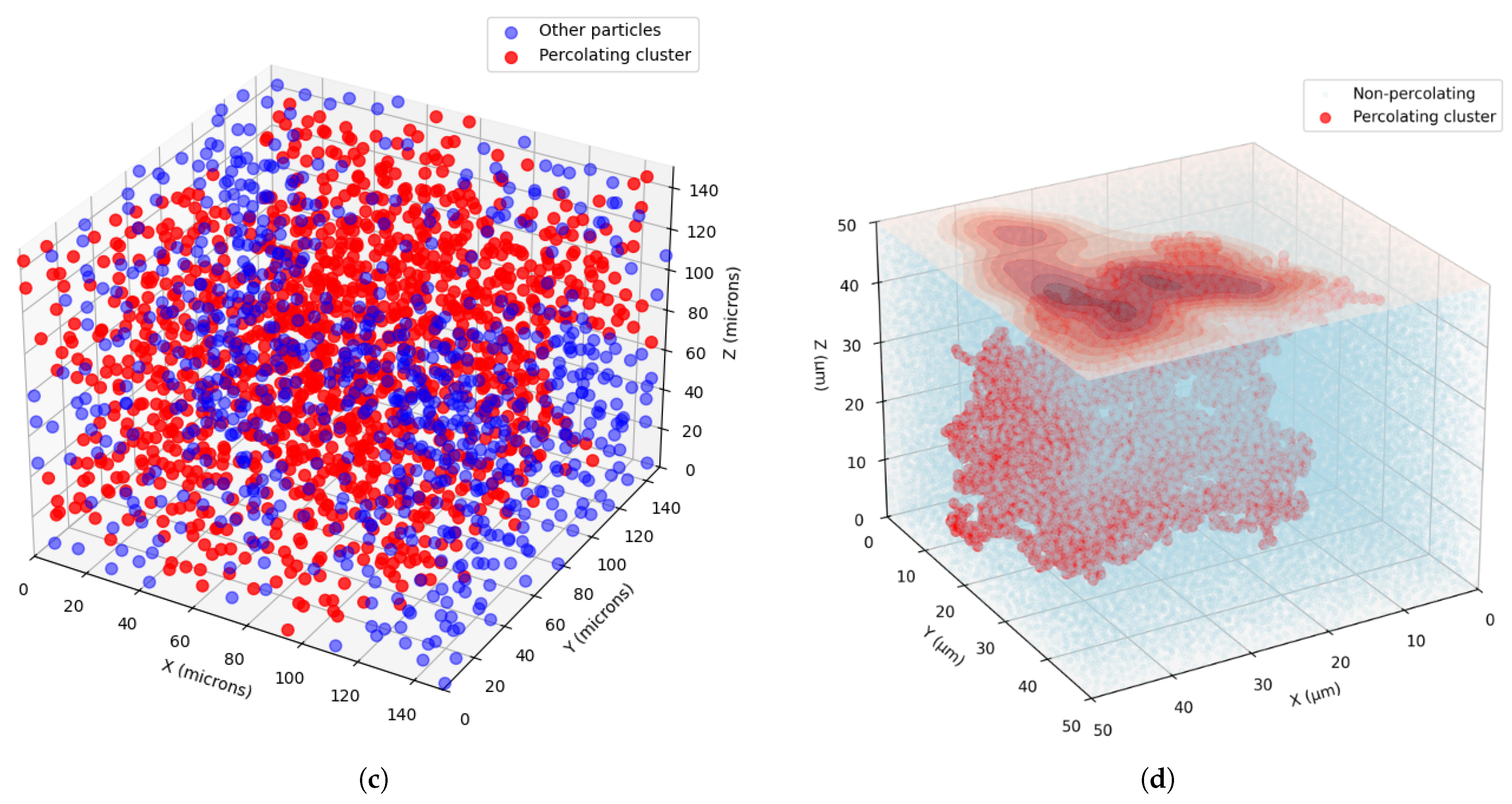Thermodielectric Properties of Polyurethane Composites with Aluminium Nitride and Wurtzite Boron Nitride Microfillers: Analysis Below and near Percolation Threshold
Abstract
1. Introduction
- The variation in thermal conductivity k and dielectric permittivity with respect to filler type, volume fraction , and temperature 25 °C < 120 °C.
- The transition from isolated filler contributions for volume fraction to the establishment of a connected filler network and its impact on the overall properties for volume fractions and higher.
- Comparison of the experimental results with the theoretical model proposed by Nan et al. [21].
- The addressal of the fabrication challenges at high filler loadings and proposal of scalable processing routes.
- An outline of the prospects for hybrid filler systems and practical application in next-generation battery modules for electric aircraft.
2. Theory
2.1. Thermal Conductivity
- Filler Conductivity (): A higher improves ; however, the low k of the polymer matrix tempers the enhancement.
- Volume Fraction (): An increasing filler volume fraction creates additional conductive pathways, although the benefit may level off due to interfacial limitations.
- Interfacial Thermal Resistance: This resistance, commonly known as the Kapitza resistance (), arises from mismatches in the phonon properties between the soft organic bonds in PUR (e.g., C–H and C–O) and the rigid bonds in AlN (Al–N) or wBN (B–N). Typical values of yield an interfacial conductance of .
- Filler Geometry: Spherical fillers (aspect ratio ) are generally less effective than anisotropic fillers, such as platelets or rods (), which can align to create more efficient thermally conductive chains.
2.2. Dielectric Permittivity
2.3. Percolation
2.4. Thermal Conductivity and Dielectric Permittivity Prediction Framework
3. Materials and Methods
3.1. Materials
3.2. Fabrication
3.3. Thermal Conductivity Measurements
3.4. Dielectric Permittivity Measurements
- Voltage Measurement (): 0° and internal gain factor setting;
- Voltage Measurement (): 90°;
- Reference Measurement: 0°;
- Gain factor > 1 Gain factor = 1;
- Reference Measurement: 90° Current Measurement: 0°;
- Current Measurement (): 0° Current Measurement (): 90°;
- Current Measurement (): 90° Reference Measurement (): 0°;
- Reference Measurement 0° Reference Measurement: 90°.
4. Simulation and Experimental Data
4.1. Percolation
- Reduced mean distance between particles;
- Better particle distribution;
- Higher overall concentration.
4.2. Thermal Conductivity
4.3. Dielectric Measurement
5. Conclusions
Author Contributions
Funding
Institutional Review Board Statement
Informed Consent Statement
Data Availability Statement
Conflicts of Interest
References
- Thomas, B.; Soni, S. A Review on Polymer Nanocomposites Used in Aerospace. In Repair of Advanced Composites for Aerospace Applications; CRC Press: Boca Raton, FL, USA, 2022; p. 11. [Google Scholar] [CrossRef]
- Xue, T.; Su, X.; Yu, S.; Meng, M.; Xu, X.; Xin, J.; Ran, J. Enhanced Thermal Conductivity and Dielectric Performance of CMZBS–Glass–Ceramic Composites with AlN Whisker Incorporation for LTCC Applications. Materials 2025, 18, 857. [Google Scholar] [CrossRef]
- Ceretti, D.V.A.; Edeleva, M.; Cardon, L.; D’hooge, D.R. Molecular Pathways for Polymer Degradation during Conventional Processing, Additive Manufacturing, and Mechanical Recycling. Molecules 2023, 28, 2344. [Google Scholar] [CrossRef] [PubMed]
- Elabbasy, M.T.; Samak, M.A.; Saleh, A.A.; El-Shetry, E.S.; Almalki, A.; El-Morsy, M.; Menazea, A. Enhancement of wound dressings through cerium canadate and hydroxyapatite-infused hyaluronic acide and PVA membranes: A comprehensive characterization and biocompatibility study. Mater. Chem. Phys. 2024, 328, 129972. [Google Scholar] [CrossRef]
- Hardoň, S.; Kúdelčík, J.; Baran, A.; Trnka, P.; Michal, O.; Tamus, A.; Koltunowicz, T.; Kozaková, A.; Dérer, T.; Hornak, J. Fabrication and Broadband Dielectric Study of Properties of Nanocomposites Materials Based on Polyurethane. IEEE Access 2024, 12, 114227–114241. [Google Scholar] [CrossRef]
- Hornak, J.; Kopriva, J.; Jansa, Z.; Prosr, P.; Baran, A.; Trnka, P. Structural characterization of LLDPE/MgO insulation composites in terms of space charge accumulation in an HVDC field. Surf. Interfaces 2024, 46, 104112. [Google Scholar] [CrossRef]
- Bukichev, Y.S.; Bogdanova, L.M.; Lesnichaya, V.A.; Chukanov, N.V.; Golubeva, N.D.; Dzhardimalieva, G.I. Mechanical and Thermophysical Properties of Epoxy Nanocomposites with Titanium Dioxide Nanoparticles. Appl. Sci. 2023, 13, 4488. [Google Scholar] [CrossRef]
- Komarneni, S. Nanocomposites. J. Mater. Chem. 1992, 2, 1219–1230. [Google Scholar] [CrossRef]
- Zhou, T.; Fan, Z.; Xing, S.; Li, Y.; Zhao, L. Thermal conductivity of boron nitride reinforced polyethylene composites. Mater. Res. Bull. 2010, 45, 677–680. [Google Scholar] [CrossRef]
- Cong, H.M.; Zhao, Z.B.; Wang, Y.; Yang, X.D.; Fang, Y.; Yan, C. A high thermal conductive BN-ZnO NWs/PVA composite based on the oriented structure construction using ice template method. Ceram. Int. 2024, 50, 8961–8970. [Google Scholar] [CrossRef]
- Bagatella, S.; Cereti, A.; Manarini, F.; Cavallaro, M.; Suriano, R.; Levi, M. Thermally Conductive and Electrically Insulating Polymer-Based Composites Heat Sinks Fabricated by Fusion Deposition Modeling. Polymers 2024, 16, 432. [Google Scholar] [CrossRef]
- Kim, H.; Boudenne, A.; Ibos, L.; Candau, M.; Touati, Y.; Bellet, S.; Batsale, J.C. Effective thermal conductivity of polymer composites: Numerical and experimental studies. Polym. Compos. 2005, 26, 570–579. [Google Scholar] [CrossRef]
- Yu, G.; Cheng, Y.; Duan, Z. Research Progress of Polymers/Inorganic Nanocomposite Electrical Insulating Materials. Molecules 2022, 27, 7867. [Google Scholar] [CrossRef] [PubMed]
- Feng, C.P.; Yang, L.Y.; Yang, J.; Bai, L.; Bao, R.Y.; Liu, Z.Y.; Yang, M.B.; Lan, H.B.; Yang, W. Recent advances in polymer-based thermal interface materials for thermal management: A mini-review. Compos. Commun. 2020, 22, 100528. [Google Scholar] [CrossRef]
- Xu, R.L.; Muñoz Rojo, M.; Islam, S.M.; Smith, R.; Li, Z.; Donadio, D.; Balandin, A.A.; Razeghi, M.; Shakouri, A. Thermal conductivity of crystalline AlN and the influence of atomic-scale defects. J. Appl. Phys. 2019, 125, 185105. [Google Scholar] [CrossRef]
- Zhi, C.; Yap, Y.K. Boron nitride nanotubes. Mater. Sci. Eng. R. Rep. 2010, 70, 92–111. [Google Scholar] [CrossRef]
- Liu, B.; Ming, P.; Cheng, X.; Zhang, G. Lattice thermal transport in superhard hexagonal diamond and wurtzite boron nitride: A comparative study with cubic diamond and cubic boron nitride. Carbon 2018, 139, 1052–1058. [Google Scholar] [CrossRef]
- Bauhofer, W.; Kovacs, J.Z. A review and analysis of electrical percolation in carbon nanotube polymer composites. Compos. Sci. Technol. 2009, 69, 1486–1498. [Google Scholar] [CrossRef]
- Parvathi, K.; Ramesan, M.T. Tailoring the structural, electrical and thermal properties of zinc oxide reinforced chlorinated natural rubber/poly (indole) blend nanocomposites for flexible electrochemical devices. J. Polym. Res. 2023, 30, 55. [Google Scholar] [CrossRef]
- Ma, Y.J.; Yao, X.; Zheng, Q.; Yin, Y.; Jiang, D.; Xu, G.X.; Wei, F.; Zhang, Q. Carbon nanotube films change Poisson’s ratios from negative to positive. Appl. Phys. Lett. 2010, 97, 061909. [Google Scholar] [CrossRef]
- Nan, C.W.; Birringer, R.; Clarke, D.R.; Gleiter, H. Effective thermal conductivity of particulate composites with interfacial thermal resistance. J. Appl. Phys. 1997, 81, 6692–6699. [Google Scholar] [CrossRef]
- Angstrom, A.J. XVII. New method of determining the thermal conductibility of bodies. Lond. Edinb. Dublin Philos. Mag. J. Sci. 1863, 25, 130–142. [Google Scholar] [CrossRef]
- Hahn, J.; Reid, T.; Marconnet, A. Infrared Microscopy Enhanced Ångström’s Method for Thermal Diffusivity of Polymer Monofilaments and Films. J. Heat Transf. 2019, 141, 081601. [Google Scholar] [CrossRef]
- Kobari, T.; Okajima, J.; Komiya, A.; Maruyama, S. Development of guarded hot plate apparatus utilizing Peltier module for precise thermal conductivity measurement of insulation materials. Int. J. Heat Mass Transf. 2015, 91, 1157–1166. [Google Scholar] [CrossRef]
- Parker, W.J.; Jenkins, R.J.; Butler, C.P.; Abbott, G.L. Flash Method of Determining Thermal Diffusivity, Heat Capacity, and Thermal Conductivity. J. Appl. Phys. 1961, 32, 1679–1684. [Google Scholar] [CrossRef]
- Johansson, P.; Adl-Zarrabi, B.; Hagentoft, C.E. Using transient plane source sensor for determination of thermal properties of vacuum insulation panels. Front. Archit. Res. 2012, 1, 334–340. [Google Scholar] [CrossRef]
- Losego, M.D.; Grady, M.E.; Sottos, N.R.; Cahill, D.G.; Braun, P.V. Functionalization mediates heat transport in graphene nanoflakes. Nat. Commun. 2016, 7, 11281. [Google Scholar] [CrossRef]
- Cole, K.S.; Cole, R.H. Dispersion and absorption in dielectrics. J. Chem. Phys. 1941, 9, 341–351. [Google Scholar] [CrossRef]
- Jonscher, A.K. The “universal” dielectric response. Nature 1977, 267, 673–679. [Google Scholar] [CrossRef]
- Grosse, C. A program for the fitting of Debye, Cole–Cole, Cole–Davidson, and Havriliak–Negami dispersions to dielectric data. J. Colloid Interface Sci. 2014, 419, 102–106. [Google Scholar] [CrossRef]
- Garboczi, E.J.; Snyder, K.; Douglas, J.M.; Thorpe, M. Geometrical percolation threshold of overlapping ellipsoids. Phys. Rev. E 1995, 52, 819–828. [Google Scholar] [CrossRef]
- Smith, A.N.; Jones, B.R.; Lee, C.D. Influence of Powder Morphology on the Flowability of Alumina Powders. Powder Technol. 2020, 362, 209–218. [Google Scholar] [CrossRef]
- Bruggeman, D.A.G. Dielectric constants of mixtures. Ann. Phys. 1935, 416, 636–664. [Google Scholar] [CrossRef]
- Wiener, N. Die Theorie des Mischkörper. J. London Math. Soc. 1912, 1, 191–193. [Google Scholar]
- Agrawal, A.; Thakur, M. Thermal conductivity of polymer composites. J. Mater. Sci. 1995, 30, 473–478. [Google Scholar]
- Ngo, D.; Byon, E. Effective thermal and dielectric properties of composite materials. Compos. Sci. Technol. 2010, 70, 410–417. [Google Scholar]
- Hashin, Z.; Shtrikman, S. Theory of elastic properties of composite materials. J. Appl. Phys. 1963, 34, 22–31. [Google Scholar]
- VUKI a.s. VUKI Products. 2024. Available online: https://www.vuki.sk/en/products (accessed on 7 April 2025).
- Kúdelčík, J.; Hardoň, Š.; Trnka, P.; Michal, O.; Hornak, J. Dielectric Responses of Polyurethane/Zinc Oxide Blends for Dry-Type Cast Cold-Curing Resin Transformers. Polymers 2021, 13, 375. [Google Scholar] [CrossRef]
- Hardoň, Š.; Kúdelčík, J.; Baran, A.; Michal, O.; Trnka, P.; Hornak, J. Influence of Nanoparticles on the Dielectric Response of a Single Component Resin Based on Polyesterimide. Polymers 2022, 14, 2202. [Google Scholar] [CrossRef] [PubMed]
- Kúdelčík, J.; Hardon, S.; Hockicko, P.; Kúdelcikova, M.; Hornak, J.; Prosr, P.; Trnka, P. Study of the Complex Permittivity of a Polyurethane Matrix Modified by Nanoparticles. IEEE Access 2021, 9, 49547–49556. [Google Scholar] [CrossRef]
- Janek, M.; Kúdelčík, J.; Hardon, S.; Gutten, M. Novel, Cost Effective, and Reliable Method for Thermal Conductivity Measurement. Sensors 2024, 24, 7269. [Google Scholar] [CrossRef]
- Amphenol. Available online: https://www.amphenol-sensors.com/hubfs/Documents/AAS-920-321B-Thermometrics-NTC-Type-MA-062215-web.pdf (accessed on 27 May 2025).
- LTspice Information Center. Available online: https://www.analog.com/en/resources/design-tools-and-calculators/ltspice-simulator.html (accessed on 27 May 2025).
- Arduino Nano. Available online: https://store.arduino.cc/products/arduino-nano (accessed on 27 May 2025).
- ADS1256. Available online: https://www.ti.com/product/ADS1256 (accessed on 27 May 2025).
- Node-RED. Available online: https://nodered.org/ (accessed on 27 May 2025).
- Kúdelčík, J.; Gunya, A.; Hardon, S. Enhancement of Dielectric Responses in Cold Curing Polyurethane through Magnesium Oxide Blend Incorporation. In Proceedings of the 2023 IEEE 6th International Conference and Workshop Óbuda on Electrical and Power Engineering (CANDO-EPE), Budapest, Hungary, 19–20 October 2023. [Google Scholar] [CrossRef]
- Kúdelčík, J.; Gunya, A.; Hardon, S. Dielectric Analysis of a Polyurethane Enhanced by MgO or AlN Particles for an Application in Chemical Power Module Case. In Proceedings of the 2024 24th International Scientific Conference on Electric Power Engineering (EPE 2024), Kouty nad Desnou, Czech Republic, 15–17 May 2024. [Google Scholar] [CrossRef]
- Fluke PM6304 Manual. Available online: https://dfzk-www.oss-cn-beijing.aliyuncs.com/www-PRD/resources/files/Fluke_PM6304_umeng0200.pdf (accessed on 27 May 2025).











| (%) | 1 | 5 | 10 | 20 | 40 | 50 | 60 |
|---|---|---|---|---|---|---|---|
| 0.0035 | 0.018 | 0.036 | 0.08 | 0.2 | 0.27 | 0.36 | |
| 0.004 | 0.02 | 0.04 | 0.12 | 0.28 | 0.35 | 0.45 | |
| (W·) | 0.21 | 0.23 | 0.25 | 0.37 | 0.53 | 0.63 | 0.72 |
| (W·) | 0.21 | - | 0.35 | 0.65 | - | - | - |
| (Par—wt %) | 0 | 5 | 10 | 20 | 50 | 60 |
|---|---|---|---|---|---|---|
| 2.51 | 2.43 | 2.47 | 2.98 | 3.51 | 4.47 | |
| 22.37 | 18.73 | 9.37 | 51.80 | 28.44 | 33.85 | |
| 6.42 | 5.50 | 13.03 | 35.14 | 28.25 | 102.81 | |
| (mHz) | 25 | 29 | 12 | 5 | 6 | 2 |
| 0.16 | 0.1 | 0 | 0.37 | 0.31 | 0.2 | |
| 1 | 1 | 0.81 | 1 | 1 | 1 | |
| 31.7 | 6.11 | 16.6 | 51.2 | 5.49 | 1.95 | |
| 4.62 | 3.06 | 3.89 | 4.29 | 4.67 | 3.93 | |
| 0.33 | 0.339 | 0.225 | 0.289 | 0.343 | 0.396 | |
| 483 | 470 | 708 | 551 | 464 | 402 | |
| 0.56 | 0.171 | 0.44 | 0.51 | 0.68 | 0.74 | |
| 0.79 | 0.26 | 0.45 | 0.64 | 0.96 | 0.92 |
| (Par—wt %) | 0 | 10 | 20 | 40 |
|---|---|---|---|---|
| 2.51 | 2.95 | 2.88 | 2.62 | |
| 22.37 | 50.27 | 42.99 | 12.20 | |
| (s) | 6.42 | 23.96 | 55.89 | 99.79 |
| (mHz) | 25 | 7 | 3 | 2 |
| 0.16 | 0.33 | 0 | 0.39 | |
| 1.00 | 1.00 | 0.58 | 1.00 | |
| 31.7 | 19.1 | 17.3 | 0.97 | |
| 4.62 | 4.93 | 4.79 | 2.30 | |
| (ms) | 0.33 | 1.79 | 1.27 | 0.29 |
| (Hz) | 483 | 89 | 125 | 534 |
| 0.56 | 0.25 | 0.43 | 0.63 | |
| 0.79 | 0.29 | 0.44 | 0.71 |
Disclaimer/Publisher’s Note: The statements, opinions and data contained in all publications are solely those of the individual author(s) and contributor(s) and not of MDPI and/or the editor(s). MDPI and/or the editor(s) disclaim responsibility for any injury to people or property resulting from any ideas, methods, instructions or products referred to in the content. |
© 2025 by the authors. Licensee MDPI, Basel, Switzerland. This article is an open access article distributed under the terms and conditions of the Creative Commons Attribution (CC BY) license (https://creativecommons.org/licenses/by/4.0/).
Share and Cite
Gunya, A.; Kúdelčík, J.; Hardoň, Š.; Janek, M. Thermodielectric Properties of Polyurethane Composites with Aluminium Nitride and Wurtzite Boron Nitride Microfillers: Analysis Below and near Percolation Threshold. Sensors 2025, 25, 4055. https://doi.org/10.3390/s25134055
Gunya A, Kúdelčík J, Hardoň Š, Janek M. Thermodielectric Properties of Polyurethane Composites with Aluminium Nitride and Wurtzite Boron Nitride Microfillers: Analysis Below and near Percolation Threshold. Sensors. 2025; 25(13):4055. https://doi.org/10.3390/s25134055
Chicago/Turabian StyleGunya, Alexey, Jozef Kúdelčík, Štefan Hardoň, and Marián Janek. 2025. "Thermodielectric Properties of Polyurethane Composites with Aluminium Nitride and Wurtzite Boron Nitride Microfillers: Analysis Below and near Percolation Threshold" Sensors 25, no. 13: 4055. https://doi.org/10.3390/s25134055
APA StyleGunya, A., Kúdelčík, J., Hardoň, Š., & Janek, M. (2025). Thermodielectric Properties of Polyurethane Composites with Aluminium Nitride and Wurtzite Boron Nitride Microfillers: Analysis Below and near Percolation Threshold. Sensors, 25(13), 4055. https://doi.org/10.3390/s25134055







